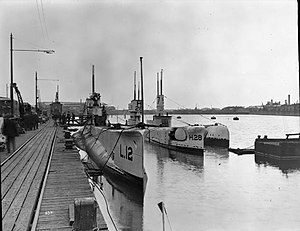HMS L12 was a L-class submarine built for the Royal Navy during World War I. She was one of five boats in the class to be fitted as a minelayer. The boat survived the war and was sold for scrap in 1932.
 HMS L12 and H28
| |
| History | |
|---|---|
| Name | HMS L12 |
| Builder | Vickers Limited, Barrow-in-Furness |
| Laid down | 22 January 1917 |
| Launched | 16 March 1918 |
| Commissioned | 30 June 1918 |
| Fate | Sold for scrapping, 16 February 1932 |
| General characteristics | |
| Class and type | L-class submarine |
| Displacement |
|
| Length | 238 ft 7 in (72.7 m) |
| Beam | 23 ft 6 in (7.2 m) |
| Draught | 13 ft 3 in (4.0 m) |
| Installed power |
|
| Propulsion |
|
| Speed |
|
| Range | 3,800 nmi (7,000 km; 4,400 mi) at 10 knots (19 km/h; 12 mph) on the surface |
| Test depth | 150 feet (45.7 m) |
| Complement | 38 |
| Armament |
|
Design and description edit
L9 and its successors were enlarged to accommodate 21-inch (53.3 cm) torpedoes and more fuel. The submarine had a length of 238 feet 7 inches (72.7 m) overall, a beam of 23 feet 6 inches (7.2 m) and a mean draft of 13 feet 3 inches (4.0 m).[1] They displaced 914 long tons (929 t) on the surface and 1,089 long tons (1,106 t) submerged. The L-class submarines had a crew of 38 officers and ratings.[2]
For surface running, the boats were powered by two 12-cylinder Vickers[3] 1,200-brake-horsepower (895 kW) diesel engines, each driving one propeller shaft. When submerged each propeller was driven by a 600-horsepower (447 kW) electric motor.[1] They could reach 17 knots (31 km/h; 20 mph) on the surface and 10.5 knots (19.4 km/h; 12.1 mph) underwater. On the surface, the L class had a range of 3,800 nautical miles (7,000 km; 4,400 mi) at 10 knots (19 km/h; 12 mph).[4]
The boats were armed with four 21-inch torpedo tubes in the bow and two 18-inch (45 cm) in broadside mounts. They carried four reload torpedoes for the 21-inch tubes for a grand total of ten torpedoes of all sizes.[5] They were also armed with a 4-inch (102 mm) deck gun.[2] L12 was fitted with 16 vertical mine chutes in her saddle tanks and carried one mine per chute.[1]
Construction and career edit
HMS L12 was built by Vickers, Barrow-in-Furness. She was laid down on 22 January 1917 and was commissioned on 30 June 1918. The boat collided with the submarine HMS H47 off Milford Haven, Wales on 9 July 1929. She was able to surface and returned to Milford Haven; three sailors died. HMS L12 was sold to John Cashmore Ltd on 16 February 1932 for scrapping at Newport.
Notes edit
References edit
- Akermann, Paul (2002). Encyclopaedia of British Submarines 1901–1955 (reprint of the 1989 ed.). Penzance, Cornwall: Periscope Publishing. ISBN 1-904381-05-7.
- Colledge, J. J.; Warlow, Ben (2006) [1969]. Ships of the Royal Navy: The Complete Record of all Fighting Ships of the Royal Navy (Rev. ed.). London: Chatham Publishing. ISBN 978-1-86176-281-8.
- Gardiner, Robert & Gray, Randal, eds. (1985). Conway's All the World's Fighting Ships 1906–1921. Annapolis, Maryland: Naval Institute Press. ISBN 0-85177-245-5.
- Harrison, A. N. (January 1979). "The Development of HM Submarines From Holland No. 1 (1901) to Porpoise (1930) (BR3043)". RN Subs. Retrieved 27 September 2022.